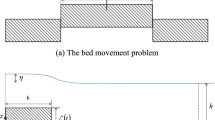Abstract
The interaction among wave, seabed and marine structure is an important issue in geotechnical engineering as well as coastal engineering. It is important for civil engineers who have to design the foundation for various marine structures and verify the instability of the seabed to understand variations of pressures and stresses in the seabed induced by waves. Previous studies showed that there are two different mechanisms in the seabed instability, particularly, in the case of wave-induced liquefaction. The first is caused by the transient or oscillatory nature of excess pore water pressure, and is accompanied by damping of the amplitude and lagging of the phase in the variation of pore water pressure. The second is caused by the residual or progressive nature of excess pore water pressure, which appears after a certain number of cyclic waves loading. This study numerically analyzed the generation of excess pore pressure in the seabed induced by a standing wave. Particularly it investigated the developing characteristics of residual excess pore pressure in the excess pore pressure generated in the seabed below the antinode and the node of a standing wave. In addition, the numerical results are compared to experimental ones. They exhibited good agreement qualitatively in the developing characteristics of the residual excess pore pressure.
Similar content being viewed by others
References
Biot, M. A. (1941). “General theory of three-dimensional consolidation.” Journal of Applied Physics, Vol. 12, pp. 155–164.
Bjerrum, L. (1973). “Geotechnical engineering problems involved in foundations of structures in the North Sea.” Geotechnique, Vol. 23, No. 3, pp. 319–358.
Christian, J. T., Taylor, P. K., Yen, J. K. C., and Erali, D. R. (1974). “Large diameter underwater pipeline for nuclear plant designed against soil liquefaction.” Offshore Technology Conference, Vol. 2, pp. 597–602.
Dean, R. G. and Dalrymple, R. A. (1991). Water wave mechanics for engineers and scientists, World Scientific, pp. 271–282.
Finn, W. D. L. and Bhatia, S. K. (1980). “Prediction of seismic pore water pressure.” Proceedings of the 10 th International Conference on Soil Mechanics and Foundation Engineering, pp. 201–206.
Henkel, D. J. (1970). “The role of waves in causing submarine landslides.” Geotechnique, Vol. 20, No. 1, pp. 75–80.
Kudella, M., Oumeraci, H., de Groot, M. B., and Meijers, P. (2006). “Large-scale experiments on pore pressure generation underneath a caisson breakwater.” Journal of Waterway, Port, Coastal, and Ocean Engineering, Vol. 132, No. 4, pp. 310–324.
Lee, K. L. and Focht, J. A. (1975). “Liquefaction potential of ekofisk tank in North Sea.” Journal of the Geotechnical Engineering Division, ASCE, Vol. 100, No. GT1, pp. 1–18.
Rahman, M. S., Seed, H. B., and Booker, J. R. (1977). “Pore pressure development under offshore gravity structures.” Journal of the Geotechnical Engineering Division, ASCE, Vol. 103, No. GT12, pp. 1419–1436.
Seed, H. B. and Rahman, M. S. (1978). “Wave-induced pore pressure in relation to ocean floor stability of cohesionless soils.” Marine Geotechnology, Vol. 3, No. 2, pp. 123–150.
Suzuki, K., Tada, K., Simosako, K., Yamazaki, H., and Kang, Y. G. (2003). “Model experiments on wave-induced liquefaction through a largescale wave flume.” Costal Engineering Journal, Vol. 50, pp. 856–860 (in Japanese).
Takahashi, S., Suzuki, K., Kang, Y. G., and Tsunekazu, K. (1997). “A series of experiment on the wave-induced liquefaction in fine sand bed.” Costal Engineering Journal, Vol. 44, pp. 916–920, (in Japanese).
Tomi, Y., Zen, K., Chen, G., Kasama, K., and Yang, S. (2008). “Flume test on wave-induced liquefaction around a breakwater in terms of relative density.” Annual Journal of Civil Engineering in the Ocean, JSCE, Vol. 24, pp. 303–808 (in Japanese).
Verruijt, A. (1969). Elastic storage of aquifers, flow through porous media, Editor de Wiest, R. J. M., Academic Press.
Yamamoto, T., Koning, H. L., Sellmeijer, H., and Hijum, E. V. (1978). “On the response of poro-elastic bed to water waves.” Journal of Fluid Mechanics, Vol. 87, No. 1, pp. 193–206.
Yang, S. (2007). Theoretical and experimental studies on the waveinduced liquefaction, PhD Thesis, Kyushu University, Fukuoka, Japan.
Yang, S. and Zen, K. (2007). “A model experiment on the wave-induced liquefaction and settlement in the loosely deposited sand bed.” Annual Journal of Civil Engineering in the Ocean, JSCE, Vol. 23, pp. 847–852.
Yang, S., Zen, K., and Kasama, K. (2008). “Comparative study of experiment results on the wave-induced liquefaction.” Proceedings of the 18 th International Offshore and Polar Engineering Conference, pp. 756–761.
Zen, K. and Yamazaki, H. (1990). “Mechanism of wave-induced liquefaction and densification in seabeds.” Soils and Foundations, Vol. 30, No. 4, pp. 90–104.
Zen, K., Umehara, Y., and Finn, W. D. L. (1986). “A case study of the wave-induced liquefaction of sand layers under the damaged breakwater.” Third Canadian Conference on Marine Geotechnical Engineering, pp. 505–520.
Author information
Authors and Affiliations
Corresponding author
Rights and permissions
About this article
Cite this article
Yang, S., Kim, N. Developing characteristics of standing wave-induced residual excess pore water pressure in the seabed. KSCE J Civ Eng 18, 2019–2027 (2014). https://doi.org/10.1007/s12205-014-0506-2
Received:
Accepted:
Published:
Issue Date:
DOI: https://doi.org/10.1007/s12205-014-0506-2




